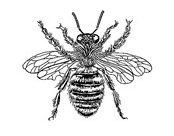When I broke ground on my first garden area 23 years ago, I knew I wanted to create a habitat for butterflies and birds, lizards and toads and such. But specifically bees? Pollinators? It wasn’t until the European honey bee’s population started to decline from Colony Collapse Disorder around 2006 that our pollinators gained some much deserved attention.

Eleven years ago, the U.S. senate voted to mark a week each year to address pollinators’ declining populations. What started as an American initiative is now a worldwide movement to “promote the health of our pollinators, critical to our food and ecosystems, through conservation, education and research.” (Mission statement from Pollinator Partnership.)
This week is National Pollinator Week. Somehow a week hardly seems enough time to celebrate our pollinators, so vitally important to our world’s food supply. Currently, about one third of the food we consume is reliant upon pollinators for production.
Pollinator Partnership reports there are 200,000 species of pollinators, with only about 1,000 of those being hummingbirds, bats and small mammals. Bees, ants, beetles, butterflies and moths make up the remaining pollinators.

After all these years of gardening in North Texas, I have several plants that I now recommend for attracting wildlife, specifically butterflies and bees. But one plant, in particular, is my favorite – and it is also one of the unsung natives that, like pollinators, deserves more attention.
Buttonbush – Cephalanthus occidentalis
This plant – large shrub or small tree, depending on how pruned – produces white perfectly spherical globes of nectar.

Butterflies, bees and other beneficial insects dine on the nectar, with birds eating the fruits in the winter. Buttonbush is also a host plant for several species of butterflies and moths.

Buttonbush is native to many areas of the United States and can be found naturally growing in wet areas. Thankfully it is highly adaptable and will grow in any soil type and in a traditional garden setting. It likes full to partial sun.

To attract pollinators, it is important to select a variety of plants so your garden features blooms throughout the growing season. Native plants are preferred, whenever possible. Be sure to include larval host plants, such as milkweed for monarchs and fennel or dill for swallowtail butterflies. And. Avoid pesticides!
Please visit Pollinator Partnership for additional information and ideas on what you can do in your own backyard or corner of the world to support pollinators.


